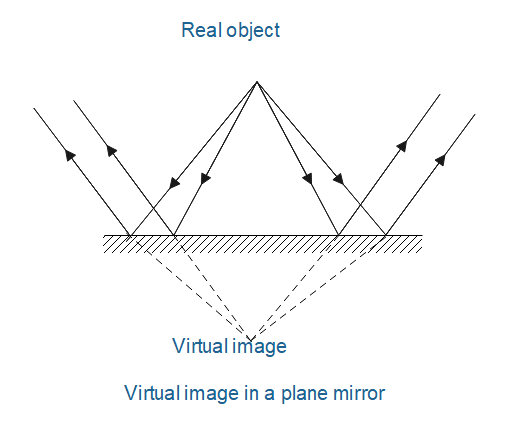Question
Question: The image formed by plane mirror is: A. Erect and diminished B. Erect and enlarged C. Inverted...
The image formed by plane mirror is:
A. Erect and diminished
B. Erect and enlarged
C. Inverted and of same size
D. Erect and of same size
Solution
Just like a concave and convex mirror, there are some characteristics of images formed by biplane mirrors. The image formed by a plane mirror is not a real image. The image formed is always upright. The size of the image formed is the same as the size of the object placed on the other side of the mirror.
Complete step by step answer:



We know that a virtual image is the image that appears to be formed at the position behind the mirror but in reality, it isn’t formed there. Because no light reaches behind the mirror. Now the image formed by a plane mirror has some properties or characteristics. One of the characteristics is, an image formed by a plane mirror is virtual, or in other words, it’s not a real image. The other characteristic of an image formed by a plane mirror is that the image formed is always erect or upright.
For instance, if you look at your image in the mirror you will see that it’s straight or erect. But will it always be erect? Not necessary. Maybe it’s inverted. Well, we can think of inverted as the opposite of upright. Yes, an inverted image means it is an upside-down image. Concave mirrors can form inverted images. The plane mirror never forms an inverted image. The third characteristic of an image formed by a plane mirror is that it’s of the same size as the object is on the other side of the mirror. For example, if the height of the person is 4 feet then the height of the image will also be 4 feet and if we bring the plane surface of the circular coin near the plane mirror then both the coin as well as its image will have the same diameter.
The image formed by a plane mirror is not upside down but it's laterally inverted. What do we mean by this? When we raise our left hand, the image in the mirror raises its right hand. Our left is the right of the image and similarly, our right is the image of the left. So an image follows left-right reversal. So we say that an image formed by a plane mirror is laterally inverted. Now we come towards the last point, the image formed is at the same distance from the mirror as the object is. You can verify this observation yourself. All you need is a chessboard and any chess piece, say, king. Keep the plane mirror at the edge of the board. Look at the position of the game as well as its image. Are they both at the same distance from the mirror? Well, you can count the number of squares in front of each. For the object, there are seven squares in front and the same for its image as well. You can move this key anywhere on the chessboard and find out if its image is always at the same distance from the mirror as that King is. So these were the characteristics of the images formed by a plane mirror.
Therefore option (D) is the correct option.
Note:
The image formed is at the same distance from the mirror as the object is. Do not get confused between these two types of mirrors. Many times students get confused between convex and concave mirrors especially about their shapes. The simple way to remember their shapes is to remember their applications. It is easy to visualize their shapes once you understood their principle of working
